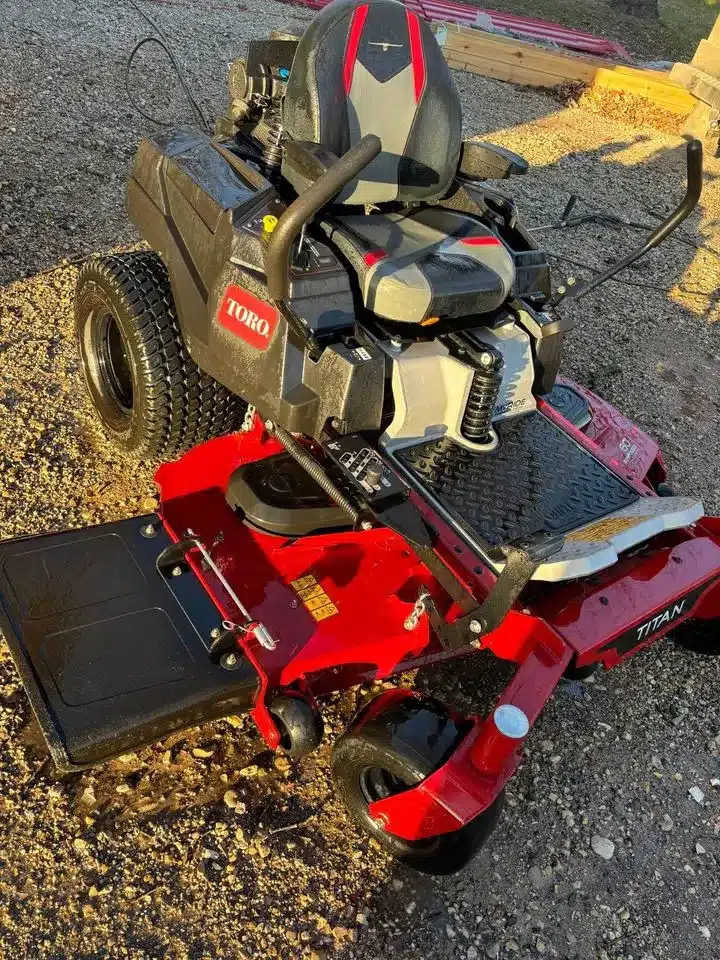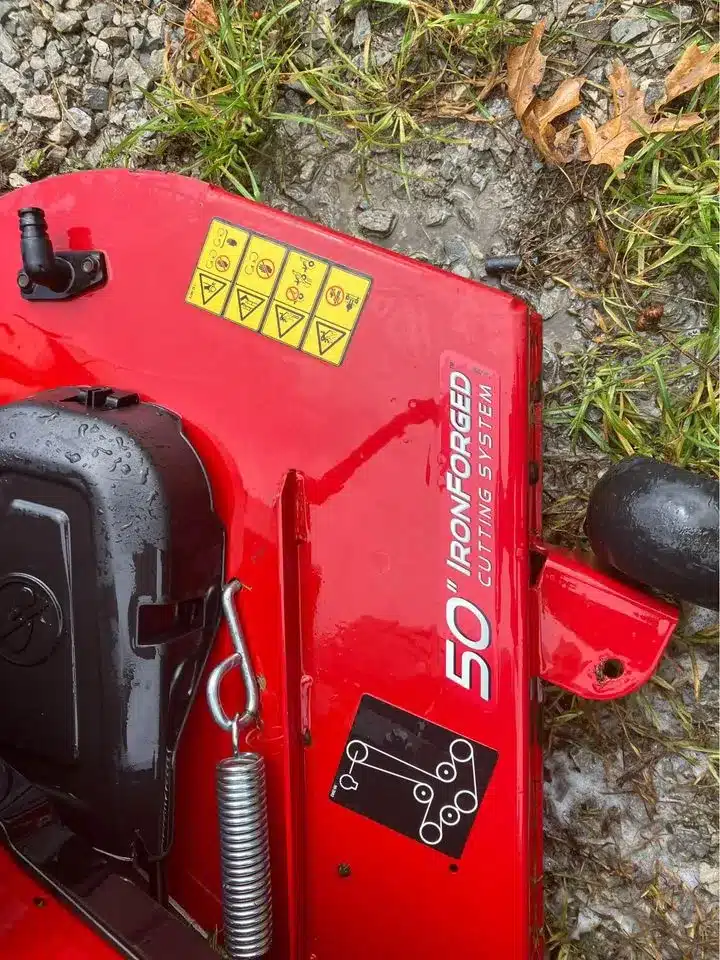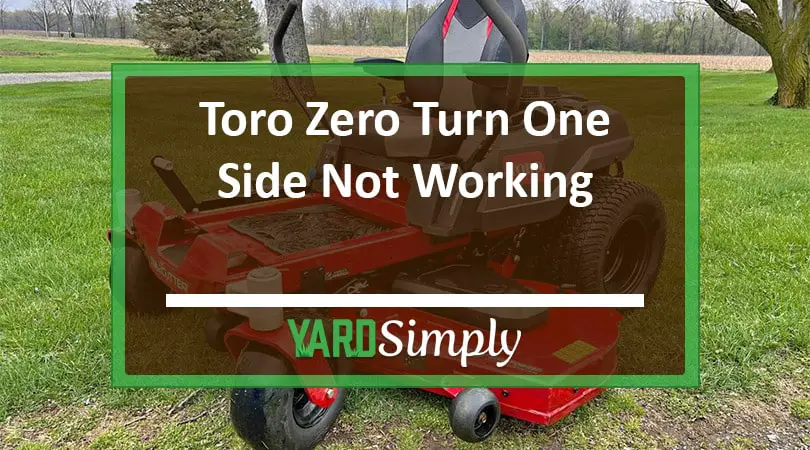As a seasoned technician specializing in Toro zero turn mowers, I bring years of hands-on experience in diagnosing and resolving mechanical issues, specifically the challenge of one side not functioning.
This guide is crafted to offer you concise, practical solutions, drawing from a deep understanding of common and complex problems associated with these machines.
Trust in my expertise to navigate you through effective troubleshooting steps, helping you restore your mower’s optimal performance efficiently. Let’s identify and fix the root cause of your Toro zero turn’s one-sided issue.
Quick Summary
- When a Toro zero turn mower’s one side isn’t working, common causes include hydraulic failure, uneven tire pressure, and issues with the freewheeling rod, drive belt, or brake system.
- Regularly checking and maintaining components like the hydraulic fluid, belt tension, and tire pressure can prevent one side of the mower from failing.
- According to lawn mower repair services, approximately 30% of their repair jobs on zero turn mowers are related to drive system failures.
- From my experience, fixing a Toro zero turn mower often requires patience and a methodical troubleshooting approach, but it’s usually a manageable task.
9 Reasons Why One Side of Your Mower Isn’t Functioning
When I encounter an issue with my Toro zero turn mower not working, particularly when one side isn’t responding as it should, hydraulic failure often emerges as the primary suspect. This usually indicates a problem within the hydrostatic drive system.
Below is a list of typical causes that can affect the performance of one side of the mower:
- Disparity in Tire Pressure Between Sides
- Activation of the Freewheeling Rod
- Brake Dragging Issue
- Wear and Tear of the Spline
- Traction Control Adjustments Needed
- Degraded or Aged Dampers
- Variations in Air Pressure Within the Hydrostatic Motor
- Problems with the Deck Belt
- Blades that are Dull or Damaged
1. Unmatched Tire Pressure on Either Side
I’ve noticed that when one side of my Toro zero turn doesn’t respond, it’s often due to uneven tire pressure.
It’s crucial to check that both tires are properly inflated to the manufacturer’s recommended level. If they’re not, it can lead to lopsided driving and reduced control over the mower.
Solution
I’ll start by checking the tire pressure on both sides to ensure they’re equally inflated for optimal performance. If the tires aren’t matched, my zero turn mower won’t have even traction, which can cause one side to lag.
2. The Freewheeling Rod Overrides

I’ve discovered that sometimes the issue with a Toro zero turn mower not functioning on one side could stem from the freewheeling rod.
If it’s engaged improperly, it’ll prevent the mower from driving on one side, acting like a safety override.
I’ll explain how to check and adjust this rod as a potential solution to the problem.
Solution
Regularly inspect the freewheeling rod on both sides of your lawn mower for any signs of bending or damage. Also, keep a close eye on the hydraulic motors as part of your routine maintenance.
Begin your assessment by examining the fluid level, followed by a thorough check of the filter, particularly on the side of the mower that seems less powerful. Should you discover any issues, prompt replacement of these components is advisable.
In some cases, a straightforward adjustment could be all that’s needed to avoid any operational interference.
3. Dragging Brake
Now, let’s turn our attention to a potential culprit: a dragging brake.
If one side of your Toro zero turn isn’t working, it’s possible that the brake on that side is sticking and needs adjustment.
I’ll guide you through identifying this issue and the steps to fix it, ensuring your mower operates smoothly again.
Solution
To address this issue, start by removing the tire. Employ a single-C clamp to apply pressure and disengage the pad, which is useful for either sliding pins or seized caliper pistons.
While you may successfully free a stuck brake, be aware that it could seize again. The underlying cause of this issue is typically corrosion, and it might take considerable time before it becomes problematic once more.
As an alternative solution for a dragging brake, consider adjusting the brake cable tension. You can find detailed guidance for this procedure in your mower’s instruction manual.
4. Stripped Spline
I’ve discovered that a stripped spline can prevent your mower’s wheel from engaging properly, which might explain why one side of your Toro zero turn isn’t working.
We’ll need to examine the drive shaft and motor coupler for any signs of wear or damage. If the splines are indeed stripped, replacing the affected parts will be our next step to get your mower running smoothly again.
Solution
To replace the spindles, begin by loosening the cover of the three-bolt assembly. Next, employ a ½-inch wrench to detach the cover from the socket.
Proceed to remove the belt with the same wrench. Afterward, loosen the pulley and carefully lower the belt using a combination of a cheater bar and a socket wrench.
Finally, utilize a 1 ⅛-inch wrench to unscrew the nut located at the top of the spline within the spindles.
5. Adjustment of the Traction
Now, let’s tackle the issue of traction adjustment, which could be the solution we’re looking for.
I’ve noticed that when one side of my Toro zero turn isn’t responding as it should, it’s often a sign that the traction needs a tweak.
I’m going to guide you through the steps to adjust it properly, ensuring both sides operate in harmony.
Solution
When you notice one side of your mower beginning to slip, it could be a sign that the traction needs adjusting. It’s wise to consult the user’s manual for the specific details tailored to your model.
Since this process can be somewhat intricate, don’t hesitate to seek expert advice if you’re uncertain.
Here’s a helpful hint from my own experience: Sometimes, reducing the tire pressure can improve traction. Moreover, if you frequently mow on hilly terrain, consider switching to larger tires.
They can significantly assist in navigating sharp turns and preventing abrupt stops.
6. Bad or Old Dampers
As I turn my attention to the issue of bad or old dampers, it’s clear they can be at the root of the problem.
If the dampers are worn out, they won’t provide the necessary tension for precise control.
Let’s explore how replacing them might just be the solution we need.
Solution
I’ve found that replacing a bad or old damper is often the key to fixing a Toro zero turn mower when one side isn’t working.
The damper is critical for smooth operation, and when it fails, you might notice a lack of responsiveness or an imbalance in the drive system, causing drag on one side.
7. Air Pressure in the Hydrostatic Motor
Now, let’s turn our attention to the role air pressure plays in the hydrostatic motor of a Toro zero turn mower.
If there’s an imbalance or leak, it can lead to one side losing power.
I’ll explain how to check for these issues and offer a solution to get both sides working in tandem again.
Solution
If your mower’s motor is experiencing air pressure issues, follow these steps to resolve it:
- Disengage the Hydrostatic Drive: Start by freeing the hydrostatic drive. To do this, either pull or push the rods on both drives to disengage them.
- Prepare the Mower: Sit on the mower and rev up the throttle to its maximum speed. Ensure that the hydrostatic drives are fully disengaged. You can switch off the mower once you’re set to proceed.
- Bleed the Air Out: Engage the forward drive of your mower and hold it for a few seconds. Then, switch to reverse and repeat these forward and reverse movements several times. This action helps remove air from the motors and bleed the hydrostatic drive system. After completing this step, turn off the engine.
- Lower the Mower: Carefully lower the jack, apply the brake, and safely get the mower back onto the ground. Re-engage the hydrostatic drives and remove any wheel chocks.
- Check and Adjust Fluid Levels: Inspect the hydrostatic fluid levels. If the levels are low, refill with the appropriate hydro fluid.
- Conduct a Test Run: Finally, perform a test run to ensure the mower is functioning correctly and the issue has been resolved.
8. Deck Belt Issues

As I turn my attention to the mower’s deck belt, I’ve realized it’s a common culprit when one side of a Toro zero turn isn’t working. I’ll need to check if the belt’s worn out or has slipped off.
A proper solution will hinge on accurately diagnosing and addressing any deck belt issues.
Solution
I often find that a malfunctioning side on a Toro zero turn mower can be attributed to issues with the deck belt. If the belt is the culprit, the fix usually involves a few key steps.
First, I make sure the mower is off and then inspect the belt for wear or damage. If it’s in poor condition, I replace it.
However, if the belt’s intact but seems loose, I’ll check the tension. I’ll adjust the belt by tightening the nut on the tensioner pulley.
Sometimes, the belt may be fine, but a stuck caliper or a seizing piston in the wheel motor can cause dragging. In that case, I’ll lubricate the caliper and check the hydraulic fluid level for the piston to solve the dragging issue.
Read More: Bad Boy Mower Belt Problems: How to Overcome
9. Dull or Broken Blade
I’ve noticed that a dull or broken blade can seriously affect my mower’s performance. If one side isn’t cutting as it should, it’s often because the blade isn’t sharp enough or has sustained damage.
I’ll need to inspect the blade and consider sharpening or replacing it to solve the issue.
Solution
To remedy a Toro zero turn’s malfunctioning side caused by a dull or broken blade, I’ll need to replace or sharpen the affected blade promptly.
If the blade is simply dull, I’ll remove it and use a blade sharpener to get it back to optimal cutting condition. However, if the blade’s broken, it’s time for a new one.
I’ll check the lawnmower’s manual to find the right replacement blade, ensuring it matches the specifications for my model.
Once the blade is sharp or new, I’ll reattach it carefully, making sure all belts and calipers are in place and secure.
After this, I should be back to mowing with a fully functional lawn mower, with both sides working efficiently to maintain my lawn’s appearance.
Our Verdict
If you’re navigating the challenges of troubleshooting your favorite Toro zero turn mower, remember the value of patience and attention to detail.
As you delve into each problem – be it a hidden issue with the freewheeling rod, uneven tire pressure, or a complex brake dilemma – view it as an opportunity to learn.
Often, the solution can be found in basic steps like inspecting the hydraulic fluid or adjusting belt tension. Every small fix you accomplish brings you a step closer to a fully operational mower.
My own journey with mower maintenance has taught me that there’s a distinct satisfaction in successfully diagnosing and resolving each problem.
So, as you tackle your own mower issues, keep in mind that with steady perseverance and methodical troubleshooting, you’ll be well on your way to getting your mower back in top shape.
Here’s to effective problem-solving and enjoyable mowing experiences!
Frequently Asked Questions
How does the type of terrain I mow on regularly affect the longevity and performance of my Toro zero turn’s transmission system?
Mowing on rough terrain puts extra strain on my mower’s transmission, potentially reducing its lifespan and performance due to increased wear and tear, compared to consistently mowing on flat, smooth surfaces.
Are there any specific maintenance routines recommended for Toro zero turn mowers that can help prevent one side from failing?
I regularly check the hydraulic fluid levels and change the filters as suggested in the maintenance schedule to keep my Toro zero turn mower running smoothly and prevent any potential issues with mobility.
Can using non-original or aftermarket parts for repairs contribute to issues with one side of the Toro zero turn mower not working properly?
Yes, using non-original parts can lead to problems; they may not fit perfectly, causing the mower to malfunction. I’ve found sticking to genuine parts ensures my equipment runs more reliably.
How does the age of my Toro zero turn mower impact the likelihood of experiencing issues with one side not functioning?
As my mower ages, wear and tear on parts is inevitable, increasing the chances of mechanical problems, which could affect its functioning, including potential issues with its maneuverability or one side’s operation.
What are the environmental or storage conditions that could adversely affect the hydrostatic system or other components of my Toro zero turn, leading to one side not working?
I’ve noticed that extreme temperatures and damp storage conditions can harm my mower’s hydrostatic system, potentially causing issues with its performance, like one side failing to operate properly.


